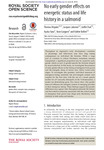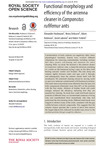Search
Now showing items 1-10 of 40
Discrete but variable structure of animal societies leads to the false perception of a social continuum
(2016)
Animal societies are typically divided into those in which reproduction within a group is monopolized by a single female versus those in which it is shared among multiple females. It remains controversial, however, whether ...
No early gender effects on energetic status and life history in a salmonid
(2015)
Throughout an organism’s early development, variations in physiology and behaviours may have long lasting consequences on individual life histories. While a large part of variation in critical life-history transitions ...
Omura’s whales off northwest Madagascar
(2015)
The Omura’s whale (Balaenoptera omurai)was describedas a new species in 2003 and then soon after as an ancient lineage basal to a Bryde’s/sei whale clade. Currently known only from whaling and stranding specimens primarily ...
New evidence on the tool assisted hunting exhibited by chimpanzees
(2015)
For anthropologists, meat eating by primates like chimpanzees (Pan troglodytes) warrants examination given the emphasis on hunting in human evolutionary history. As referential models, apes provide insight into the evolution ...
High atmospheric temperatures and ‘ambient incubation’ drive embryonic development and lead to earlier hatching in a passerine bird
(The Royal Society, 2016)
Tropical and subtropical species typically experience relatively high atmospheric temperatures during reproduction, and are subject to climate-related challenges that are largely unexplored, relative to more extensive work ...
Males migrate farther than females in a differential migrant: an examination of the fasting endurance hypothesis
(The Royal Society, 2014)
Patterns of migration including connectivity between breeding and non-breeding populations and intraspecific variation in the distance travelled are important to study because they can affect individual fitness and population ...
Tiarajudens eccentricus and Anomocephalus africanus, two bizarre anomodonts (Synapsida, Therapsida) with dental occlusion from the Permian of Gondwana
(The Royal Society, 2015)
Anomodontia was a highly successful tetrapod clade during the Permian and the Triassic. New morphological information regarding two bizarre basal anomodonts is provided and their palaeoecological significance is explored. ...
Functional morphology and efficiency of the antenna cleaner in Camponotus rufifemurants
(The Royal Society, 2015)
Contamination of body surfaces can negatively affect many physiological functions. Insects have evolved different adaptations for removing contamination, including surfaces that allow passive self-cleaning and structures ...
Sexual reproduction with variablemating systems can resist asexuality in a rock–paper–scissors dynamics
(The Royal Society, 2015)
While sex can be advantageous for a lineage in the long term, we still lack an explanation for its maintenance with the twofold cost per generation. Here we model an infinite diploid population where two autosomal loci ...
Female signalling tomale song in the domestic canary, serinus canaria
(The Royal Society, 2015)
Most studies on sexual selection focus on male characteristics such as male song in songbirds. Yet female vocalizations in songbirds are growing in interest among behavioural and evolutionary biologists because these ...










